Деревянно-каркасное здание гостиницы: противопожарные завесы и расчет эвакуации
Автор: Гравит М.В., Кирик Е.С., Шабунина Д.Е., Каримова Е.И., Хлебникова К.А.
Журнал: Строительство уникальных зданий и сооружений @unistroy
Статья в выпуске: 3 (108), 2023 года.
Бесплатный доступ
Объект исследования – здание гостиницы с деревянными панельными конструкциями. Целью работы является исследование зависимости динамики пожарной опасности от проекта пятиэтажной гостиницы с деревянной конструкцией. Метод. Программный комплекс «Сигма ПБ» использовался для создания компьютерной модели здания и моделирования (распространение пожара и эвакуация). Сформулированы случаи (сценарии), смоделированы распространение факторов пожарной опасности и эвакуация в условиях пожара. Полученные результаты. Показано существенное влияние конструкции помещения и времени начала эвакуации на условия эвакуации. Основную опасность для людей представляет дым, образующийся при сжигании горючих материалов (мебели, приборов, одежды) в здании при эвакуации. Материал деревянных конструкций здания на этом этапе не представляет опасности для людей, здание не теряет прочности, а пути эвакуации не претерпевают геометрических изменений в период эвакуации. Рассмотрен неблагоприятный сценарий несоблюдения условий беспрепятственной и своевременной эвакуации из-за задымления. Для ограничения распространения опасных факторов пожара было смоделировано использование противопожарной завесы. Было доказано, что класс огнестойкости EI 15 достаточен для обеспечения безопасной эвакуации.
Противопожарные шторы, пожарная безопасность, пожарная опасность, эвакуация, деревянное строительство
Короткий адрес: https://sciup.org/143180504
IDR: 143180504 | УДК: 69 | DOI: 10.4123/CUBS.108.4
Текст научной статьи Деревянно-каркасное здание гостиницы: противопожарные завесы и расчет эвакуации
-
1 Введение / Introduction
Возведение зданий из клееной древесины становится все более актуальным направлением в строительстве [1], [2]. Данное явление связано с тем, что клееная древесина обладает высокой прочностью и устойчивостью к различным видам нагрузок, что делает ее подходящим материалом для строительства многоэтажных зданий [3]. Кроме того, клееная древесина является экологически чистым материалом, который производится без использования токсичных веществ и процессов, что позволяет возводить здания, которые не только имеют привлекательный внешний вид, но и не наносят вреда окружающей среде [4], [5].
Использование клееной древесины вызывает как большой интерес, так и определенную осторожность в применении в строительстве многоэтажных зданий, включая жилые и общественные [6], [7]. В основной массе такие опасения связаны с горючестью древесины как строительного материала, в связи с чем возникает задача оценки влияния пожароопасных свойств древесины на обеспечение безопасных условий при эвакуации [8], [9].
На условия эвакуации при пожаре влияют объемно-планировочные решения здания, геометрические параметры путей эвакуации, количество эвакуационных выходов с этажей, время начала эвакуации, параметры горючей нагрузки (ГН). Так же исход эвакуации при пожаре определяет количество людей и состав контингента [10], [11]. Предполагается, что пути эвакуации являются геометрически неизменными в процессе эвакуации, горючую нагрузку образуют только предметы интерьера, вещи. В случае с деревянными ограждающими конструкциями эти предположения не редко подвергаются сомнению [6], [7].
В настоящем исследовании дается оценка опасности, которую могут вносить конструкции в условия обеспечения безопасной эвакуации, изучается вовлечение конструкций здания в процесс горения в течение эвакуации на примере пятиэтажного здания гостиницы с деревянными конструкциями. Выполнено моделирование развития пожара и эвакуации для нескольких сценариев. Изучались динамика нарастания опасных факторов пожара (ОФП) на путях эвакуации и процесс эвакуации, проверялись условия на путях эвакуации с точки зрения обеспечения безопасности людей [13]: беспрепятственность и своевременность. Выполнена оценка вклада горючей нагрузки, присутствующей в здании, и материала ограждающих конструкций здания в формирующуюся опасность для людей. Для сдерживания распространения ОФП по путям эвакуации исследован эффект применения противопожарных штор. Рассматривалось влияние этой меры как на состояние путей эвакуации, так и изучались последствия для конструкций в случае реализации данной меры сдерживания распространения ОФП по зданию и путм эвакуации. Для расчетов использовался российский программный комплекс «Сигма ПБ» , реализующий полевую модель развития пожара [14]– [16] и индивидуально-поточную модель эвакуации [17], [18], что наиболее полно отвечает задачам исследования [15], [19].
-
2 Материалы и методы / Materials and Methods
Рассматривается пятиэтажное прямоугольное в плане здание с каркасной конструктивной схемой. Несущие конструкции выполнены из LVL-бруса и CLT-панелей. Архитектурная высота составляет 22.1 м, пожарно-техническая высота (характеризующаяся разностью отметок проезда пожарных машин и нижней отметкой оконного блока пятого этажа) составляет 15.9 м, размеры в плане 32м х 48 м. По классу функциональной пожарной опасности здание относится к Ф1.2. Для обеспечения эвакуации в здании запроектировано 3 лестничных клетки типа Н2 с выходами непосредственно на улицу, так же на первом этаже имеется 4 рассредоточенных эвакуационных выхода из здания. Планы первого и типового этажей гостиницы представлены на Рисунках 1 и 2. Была построена компьютерная 3D-модель здания для выполнения моделирования развития пожара и эвакуации в программном обеспечении «Сигма ПБ», Рисунок 3.

Рис. 1 - План первого этажа гостиницы, размеры 32м на 48м
Fig. 1 - Ground floor plan of the hotel 32m x 48m in size

Рис. 2 – План типового этажа гостиницы, размеры 32м на 48м
Fig. 2 - The plan of a typical hotel floor 32m x 48m in size

Рис. 3 - Модель здания в «Сигма ПБ»
Fig. 3 - Building model in Sigma PB
Чтобы можно было оценивать воздействие опасных факторов пожара на людей, в расчетную область для моделирования развития пожара включены помещения с очагом пожара и все пути, по которым эвакуируются люди наружу из здания (коридоры на каждом этаже и связанный с ними объем атриума, лестничные клетки), все проемы между помещениями, вошедшими в расчетную область, приняты открытыми (это позволит проверить, именно, влияние объемно-планировочного решения на распространение ОФП). Для моделирования развития пожара применялась полевая модель, которая позволяет рассматривать развития пожара в трехмерном пространстве. Для этого требуется дисктретизация расчетной области и построение расчетной сетки, Рисунок 4: выбран шаг сетки 0.2х0.2х0.2 м3 для помещений с очагом пожара, 0.3х0.3х0.3 м3 – для помещений на этаже с очагом, 0.4х0.4х0.4 м3 – для остальных помещений.
На всех границах расчетной области приняты адиабатные условия, то есть обеспечивалась максимальная концентрация тепла внутри расчетной области. В таких условиях оценка времени достижения температурой критических значений можно считать оценкой снизу, а оценку величины самого параметра – оценкой сверху. Температура внутри расчетной области в начальный момент времени и снаружи принималась равной 200С. Горючая нагрузка выбиралась, исходя из функционального назначения помещений [22] – «жилые помещения» и «гардеробы». Площадь области расположения ГН определялась из условия нарастания номинальной мощности в течение времени эвакуации c учетом линейной скорости принятой нагрузки, то есть не мене 8 м2 [23], [24], Таблица 2. Удельная масса нагрузки также принималась из соображений поддержания горения загоревшимся участком в течение всего времени моделирования эвакуации и равна 10 кг/м2.

Рис. 4 - Расчетная сетка для моделирования распространения ОФП
Fig. 4 - Computational grid for modeling the spread of fire hazards
Количество людей на каждом этаже принято в соответствии с Таблицей 1. Учитывались маломобильные граждане, передвигающиеся самостоятельно групп мобильности М2 и М3. Рассмотрены четыре места размещения очага пожара, характеристики сценариев пожара представлены в Таблице 2. Расчетную область для моделирования эвакуации составили помещения, в которых в начальный момент находились люди, пути эвакуации (коридоры, холлы, лестницы), Рисунок 3.
В соответствии с [17] время начала эвакуации t нэ принято 120 с (здания гостиниц, оборудованные системами оповещения и управления эвакуацией людей III–V типов). Значение времени начала эвакуации для помещения очага пожара t нэ принято по формуле П5.1 Приложения 5 в [17].
Таблица 1. Количество людей на этаже в соответствии с категориями МГН Table 1. The number of people on the floor according to the categories of limited mobility people
|
Сценарии 1-4 |
М1 |
М2 |
М3 |
|
1 этаж |
74 |
2 |
2 |
|
2 этаж |
34 |
2 |
2 |
|
3 этаж |
34 |
2 |
2 |
|
4 этаж |
34 |
2 |
2 |
|
5 этаж |
34 |
2 |
2 |
|
Итого в здании |
210 |
10 |
10 |
-
3 Результаты и обсуждение / Results and Discussion
Выполненные расчеты показывают, что в рассмотренных сценариях при принятых условиях безопасность для людей в период эвакуации не обеспечивается, Таблица 2 – люди не успевают покинуть участки здания до достижения ОФП предельно-допустимых значений. В первую очередь это связано с беспрепятственным распространением ОФП по путям эвакуации из помещения с очагом пожара.
Таблица 2. Сценарии пожара и результаты расчетов
Table 2. Fire scenarios and calculation results
|
№ |
Описание сценария пожара |
Результаты расчета |
Обеспечение своевременной эвакуации |
|
1 |
Очаг на 1 этаже в зоне гардероба. Площадь очага составляет 20 м2, объем помещения составляет 70 м3, помещение очага связано с атриумом через открытый проем, |
В первую очередь задымление достигает предельного значения в коридоре пятого этажа примерно на 300 с от начала |
Не обеспечивается |
|
№ |
Описание сценария пожара |
Результаты расчета |
Обеспечение своевременной эвакуации |
|
ГН расположена в гардеробе |
пожара. Эвакуация из здания заканчивается к 220 с. Опасности подвергаются люди на первом этаже в административной части рядом с очагом |
||
|
2 |
Очаг на 1 этаже в атриуме. Площадь очага составляет 16м2, объем помещения составляет 4400 м3, ГН расположена в зоне жилых помещений |
В первую очередь задымление достигает предельного значения в коридоре пятого этажа, и происходит это до начала эвакуации на 120 с |
Не обеспечивается |
|
3 |
Очаг в цехе пищеблока на 1 этаже. Площадь очага составляет 8.57 м2, объем помещения составляет 30 м3, помещение очага связано с примыкающим коридором пищеблока через открытый проем, ГН расположена в зоне административные помещения |
Наибольшую опасть этот сценарий имеет для людей, находящихся в пищеблоке, через 60 с от начала пожара пути эвакуации в пищеблоке становятся небезопасными |
Не обеспечивается |
|
4 |
Очаг в помещении отдыха гостей на 5 этаже. Объем помещения составляет 165 м3, помещение очага связано с коридором 5-го этажа и атриумом через открытый проем, ГН расположена в жилых помещениях. Из схемы эвакуации исключается ближайшая к очагу лестница |
В первую очередь задымление достигает предельного значения в коридоре пятого этажа, и происходит это до начала эвакуации на 120 с |
Не обеспечивается |
Наибольшую опасность для людей в процессе эвакуации представляет задымление, которое формируется сгоранием горючей нагрузки, находящейся в здании. Рассмотрим подробно это утверждение на примере сценариев 2 и 4.

б)
а)
Рис. 5 - Положение людей при эвакуации и поля оптической плотности дыма в сценариях 2 (а) и 4 (б) на 135 с (красный цвет соответствует критическому значению 0.12Нп/м [17])
Fig. 5 - The position of people during evacuation and optical density fields in scenarios 2 (a) and 4 (б) at 135 sec (red color corresponds to a critical value of 0.12 Np/m [17])

Рис. 6 - Положение людей при эвакуации и поля температуры в сценариях 2 (слева) и 4 (справа) на 135с (красный цвет соответствует критическому значению 700С [17])
Fig. 6 - The position of people during evacuation and temperature fields in scenarios 2 (left) and 4 (right) at 135 sec (red color corresponds to the critical value of 70 0С [17])


Рис. 7 - Положение людей при эвакуации и поля температуры в сценариях 2 (слева) и 4 (справа) на 220с (красный цвет соответствует значению 2700С – температура обугливания древесины, СП 64)
Fig. 7 - The position of people during evacuation and temperature fields in scenarios 2 (left) and 4 (right) at 220 sec (red color corresponds to the value 2700С – the temperature of wood charring

а) б)


в) г)
Рис. 8 - Сценарий 2, изоповерхность температуры 2700С на 220 с (а) и распределение температуры по поверхности стен здания на 500 с (б);
Сценарий 4, распределение температуры по поверхности стен здания на 220 с (в) и 550 с (г);
(красный цвет соответствует значению 2700С)
Fig. 8 - Scenario 2, the isosurface temperature of 2700С at 220 sec (a) and the temperature distribution over the surface of the walls of the building at 500 sec (b);
Scenario 4, temperature distribution over the surface of the walls of the building at 220 sec (c) and 550 sec (d); (red color corresponds to the value of 2700С)
На Рисунке 5 и 6 представлены поля оптической плотности дыма в сценариях 2 и 4 на 135 секунде, то есть через 15 минут после начала эвакуации. Срезы сделаны на уровне 1.7 м от пола этажей. Из рисунков видно, что условия на момент начала эвакуации не являются безопасными. При этом температура к этому моменту не представляет опасности для людей, Рисунок 6.
Из Рисунка 7 видно, что и к моменту окончания эвакуации не приходится говорить о достижении критического значения температуры для начала обугливания древесины, равного t=270 0С [25], в среднем в объеме здания.
Рисунок 8б показывает распределение температуры по поверхности к 500 с и изоповерхность температуры, равную 2700С, Рисунок 8а, к моменту окончания эвакуации в сценарии 2. Основание конуса имеет диаметр не более 3 метров, при линейной скорости принятой ГН 0.007 м/с это соответствует площади загоревшейся области к 220 секунде при радиальной модели очага пожара [17].
В сценарии 4 к моменту окончания эвакуации ограждающие конструкции здания не вносят вклад в опасность для людей, создаваемую пожаром, Рисунок 8в. В силу меньшего объема помещения с очагом нарастание температуры до значения критического для необработанной древесины происходит быстрее (в сравнении со Сценарием 2), и можно говорить о том, что к 500 секунде необработанная поверхность ограждающих конструкций уже может представлять горючую нагрузку, Рисунок 8г. При этом говорить об изменении геометрических параметров путей эвакуации к этому моменту не приходится, поскольку требуется время на прогар и потерю несущей способности и целостности.
В Сценариях 2 и 4 применялась одинаковая горючая нагрузка (жилые помещения [22]). По представленным результатам моделирования развития пожара наглядно видно, как влияет объемно-планировочное решение на динамику распространения ОФП в период эвакуации, Рисунки 5-7, как изменяется состояние среды внутри здания с точки зрения вовлечения необработанных деревянных конструкций в процесс горения, Рисунки 8б и 8г. Наибольшая опасность для конструкций возникает в случае размещения очага в помещении малой высоты (в данном случае 3 м).
Выполнен ряд дополнительных расчетов, в которых проверялось влияние геометрических характеристик путей эвакуации на обеспечение безопасных условий эвакуации. Очевидным является факт, что увеличение высоты и ширины коридоров зданий имеет экономически и технологически обоснованные пределы. Показано, что в рамках таких ограничений только изменением геометрических параметров (высоты, ширины коридоров) не обойтись. Требуются изменения других важных условий, например ограничения распространения ОФП на путях эвакуации из помещения с очагом пожара или, как в случае с атриумом, защита путей эвакуации на вышележащих этажах от пространства атриума. Таким ограничивающим средством, могут выступать, например, стационарные экраны или противопожарные шторы [26].
-
4 Применение противопожарных штор/ Application of fire curtains
В научной литературе термином «противопожарные шторы» характеризуются конструкции, предотвращающие распространение горения и связанных с ним опасных факторов пожара (тепловой поток, дым, CO, CO 2 , HCL и др.) по зданию [20], [21]. Противопожарные шторы также употребляются под терминами «огнезащитные шторы», «дымозащитные шторы», «огнедымозащитные шторы» и т.д, в зависимости от назначения и методов испытаний. В случае возникновения пожара применение противопожарных штор позволяет локализовать очаг возгорания, предотвращая распространение огня и дыма по объему здания, создавая условия для проведения своевременной эвакуации людей.
Покажем использование противопожарных штор для локализации очага пожара на примере двух сценариев – при расположении горючей нагрузки в помещении гардероба первого этажа, Сценарий 1, и расположении ГН в помещении отдыха гостей на 5 этаже, Сценарий 4. Объемы помещений с очагом пожара для Сценария 1 и Сценария 4 составляют соответственно 21 м3 и 165 м3.
В программе «Сигма ПБ» моделирование работы противопожарной шторы осуществляется посредством изолирования помещения с ГН от остального объема здания в заданный момент времени от начала пожара. Такой подход можно считать приближенно имитирующим реальную ситуацию с применением противопожарных штор.
Gravit, M.; Kirik, E.; Shabunina, D.; Karimova, E.; Khlebnikova, K.
Wood-Frame Hotel Building: Fire Curtains and Evacuation Analysis;
Наиболее часто в технической документации скорость закрывания противопожарной шторы равна 0.15 м/с. При высоте этажа 3 м время полного закрывания шторы составит 20
секунд. Принимаем с учетом инерционности пожарной автоматики и иных задержек, что через 60 секунд от начала пожара помещение с ГН будет изолировано от основного объема здания посредством полного опускания противопожарной шторы. В течение 60 секунд будет происходить выход продуктов горения в объем примыкающего пространства.
Рассмотрим эффект от применения противопожарных штор в части состояния задымленности путей эвакуации, и посмотрим на локальную динамику температуры для оценки влияния данной меры на конструкции.
В сценарии 1 очаг располагается в гардеробе на первом этаже и основную опасность представляет для людей, находящихся в административной части этажа, Рисунок 9а. В то же время, для людей на 2–5 этажах очаг в этом месте представляет меньшую опасность, и люди успевают дойти до лестничных клеток в безопасных условиях, Рисунок 9б.

а)
Рис. 9 - Положение людей при эвакуации и поля оптической плотности в сценарии 1 на первом этаже (а) и на балконах верхних этажей (б) на 135 с (красный цвет соответствует критическому значению 0.12 Нп/м [17])
Fig. 9 - Position of people during evacuation and optical density fields in scenario 1 on the first floor (a) and on the balconies of the upper floors (b) at 135 sec (red color corresponds to the critical value of 0.12 Np/m [17])

б)
Таким образом, локализация распространения ОФП (применение противопожарной шторы) при очаге в гардеробе оказывает благоприятное воздействие на условия эвакуации на первом этаже. На Рисунке 10 а показано поле задымления на 135 секунде от начала пожара, видно, что безопасные условия эвакуации обеспечиваются на всех этажах здания. За 60 секунд выход продуктов горения произошел в объеме не опасном для людей на этажах здания, включая первый этаж.
В сценарии 4 наблюдается аналогичная ситуация: изолирование очага пожара на 60 секунде от начала пожара способствует обеспечению безопасных условий эвакуации, Рисунок 10 б, в сравнении с вариантом, когда сдерживание распространения ОФП по путям эвакуации не происходит, Рисунок 5б.

а) б)
Рис. 10 - Положение людей при эвакуации и поля оптической плотности в сценариях 1 (а) и 4 (б) на 135 с (красный цвет соответствует критическому значению 0.12 Нп/м [17])
Fig. 10 - The position of people during evacuation and optical density fields in scenarios 1 (left) and 4 (right) at 135 sec (red color corresponds to a critical value of 0.12 Np/m [17])
При этом локализация продуктов горения оказывает обратный эффект в части скорости нарастания температуры в помещении с очагом пожара, и, чем меньше объем помещения, тем более выражен этот эффект. На 120 секунде (к моменту начала эвакуации) в гардеробе температура на поверхности ограждающих конструкций уже достигла значения начала обугливания древесины, 2700С, Рисунок 11а. То есть можно считать, что к этому моменту в случае использования древесины без огнезащиты конструкции начинают вовлекаться в горение. Однако вклад этого горения в опасность пожара для людей не происходит, поскольку помещение с очагом на этот момент изолировано от путей эвакуации.

а)

б)
Рис. 11 - Эффект применения противопожарных штор. (а) Сценарий 1, изоповерхность температуры 2700С с и вертикальные срезы поля температуры на 120 с;
(б) Сценарий 4, изоповерхность температуры 2700С с и вертикальные срезы поля температуры на 120 с
Fig. 11 - The effect of applying fire curtains. (a) Scenario 1, isosurface temperature 2700C s and vertical temperature field slices at 120 sec;
(b) Scenario 4, isosurface temperature of 2700C s and vertical slices of the temperature field at 120 sec

а)

б)
Рис. 12 - Эффект применения противопожарных штор. (а) Сценарий 1, распределение температуры по поверхности стен в помещении с очагом и вертикальные срезы поля температуры на 220 с (красный цвет соответствует значению 2700С);
(б) Сценарий 4, распределение температуры по поверхности стен в помещении с очагом и вертикальные срезы поля температуры на 220 с (красный цвет соответствует значению 2700С)
Fig. 12 - The effect of fire curtains. (a) Scenario 1, temperature distribution over the wall surface in the room with the hearth and vertical slices of the temperature field at 220 sec (red color corresponds to the value of 2700C);
(b) Scenario 4, temperature distribution over the wall surface in the room with the hearth and vertical slices of the temperature field at 220 sec (red color corresponds to the value of 2700C)
В этом случае в первую очередь стоит давать оценку продолжительности периода сохранения несущих свойств ограждающими конструкциями. По самым грубым оценкам при толщине бруса 15–20 см это время составляет не менее 15–20 минут. В то же время, в помещении большего объема (Сценарий 4, Рисунок 11б) к 120 секунде горит только горючая Gravit, M.; Kirik, E.; Shabunina, D.; Karimova, E.; Khlebnikova, K.
Wood-Frame Hotel Building: Fire Curtains and Evacuation Analysis;
нагрузка, температура на поверхности стен не достигает критического значения для необработанной древесины.
В Сценарии 4 только к четвертой минуте температуру в изолированной области можно считать достигшей критического значения для вовлечения конструкций в процесс горения, Рисунок 12а. К этому моменту эвакуация уже закончена.
Таким образом, распространения ОФП имеет наибольший эффект в случае, если очаг пожара находится на этаже с коридорной системой путей эвакуации. С другой стороны, очевидно, если очаг находится в помещении ограниченного объема, то локализация ОФП приводит к более высокой скорости локального роста температуры, воздействующей на конструкции, и критическая температура обугливания древесины достигается быстрее.
-
5 Заключение / Conclusions
На основе результатов проведенных расчетов развития пожара и эвакуации для пятиэтажного здания гостиницы сделаны следующие выводы:
-
1) в период эвакуации основную опасность для людей представляет дым, образующийся при горении горючей нагрузки, находящейся в здании (мебель, одежда, бытовая техника, предметы интерьера), температура на путях эвакуации не достигает критических значений для людей к моменту окончания эвакуации;
-
2) если не происходит изолирование очага пожара, и ОФП свободно распространяются по зданию, то материал незащищенных деревянных конструкций в период эвакуации не представляет опасность для людей и не является горючим материалом, усиливающим опасность пожара для людей. Конструкции не теряют своей прочности, пути эвакуации не претерпевают геометрических изменений в период эвакуации и к ее окончанию в рассмотренном пятиэтажном здании гостиницы;
-
3) для некоторых сценариев изолирование очага пожара требуется для обеспечения безопасных условий эвакуации для людей. Показано, что применение противопожарных штор является действенным мероприятием, ограничивающим распространение опасных факторов пожара. Однако в этом случае происходит локальное увеличение температуры, и в случае применения необработанной древесины можно говорить о создании условий, при которых конструкции, ограждающие помещение с очагом пожара, вовлекаются в процесс горения;
-
4) противопожарные шторы не вносят дополнительный вклад в опасность пожара для людей в процессе эвакуации и, по грубым оценкам, их целостность может сохраняться до 15–20 минут. При этом, если противодымная штора должна обеспечить сдерживание ОФП до окончания эвакуации (в рассмотренном случае это не более четырех минут, в среднем для зданий до 10 этажей эвакуация заканчивается в течение 10 минут), то возможно использование противопожарных преград с небольшими пределами огнестойкости (достаточно EI15) для обеспечения безопасной эвакуации.
-
6 Финансирование / Fundings
Исследование выполнено за счет гранта Российского научного фонда № 23-29-00618, https://rscf.ru/project/23-29-00618/.
The research was funded by the Russian Science Foundation (RSF) under Grant No. 23-2900618,
Список литературы Деревянно-каркасное здание гостиницы: противопожарные завесы и расчет эвакуации
- Arlet, J.L. (2021) Innovative Carpentry and Hybrid Joints in Contemporary Wooden Architecture. Arts, 10, 64. https://doi.org/10.3390/arts10030064.
- Li, H., Wang, L., Wei, Y., Wang, B.J. and Jin, H. (2022) Bending and Shear Performance of Cross-Laminated Timber and Glued-Laminated Timber Beams: A Comparative Investigation. Journal of Building Engineering, 45, 103477. https://doi.org/10.1016/j.jobe.2021.103477.
- Berggren, B. and Wall, M. (2019) Review of Constructions and Materials Used in Swedish Residential Buildings during the Post-War Peak of Production. Buildings, 9, 99. https://doi.org/10.3390/buildings9040099.
- Kosov, I. (2019) Wooden clt panels in the construction of public buildings. International Journal of Applied Sciences and Technologies Integral, Limited Liability Company Electronic Science, 2-1, 253–259. https://elibrary.ru/item.asp?id=38217145.
- Nagruzova, L., Saznov, K. and Aytbu, K. kyzy. (2019) Thermal Efficient Panels on a Wooden Frame for Quickly Erectable Low-Rise Buildings. E3S Web of Conferences, 110, 01023. https://doi.org/10.1051/e3sconf/201911001023.
- Gerasimovich, A.A. and Agafonov, S.A. (2020) Overview of the world experience in the design and construction of multi-storey buildings based on glued wooden structures. Bulletin of the Magistracy, Limited Liability Company Colloquium, 70–77. https://elibrary.ru/item.asp?id=49885336.
- Pekhotikov, A., Abashkin, A., Gomozov, A. and Golkin, A. (2023) Modern Requirements for Fire Protection of Multi-Apartment Residential Buildings Having Structures Made of Cross-Laminated Timber. Pozharovzryvobezopasnost/Fire and Explosion Safety, 32, 28–40. https://doi.org/10.22227/0869-7493.2023.32.01.28-40.
- Ohashi, H., Igarashi, S. and Nagaoka, T. (2018) Development of Wood Structural Elements for Fire Resistant Buildings. Journal of Structural Fire Engineering, 9, 126–137. https://doi.org/10.1108/JSFE-11-2016-0019.
- Malo, K.A., Abrahamsen, R.B. and Bjertnæs, M.A. (2016) Some Structural Design Issues of the 14-Storey Timber Framed Building “Treet” in Norway. European Journal of Wood and Wood Products, 74, 407–424. https://doi.org/10.1007/s00107-016-1022-5.
- Samoshin, D. (2004) Calculation of the Time of Evacuation of People. Problems and Prospects. Fire and explosion safety, Pozhnauka Publishing House LLC, 13, 33–46. https://elibrary.ru/item.asp?id=17868660.
- Gravit, M., Dmitriev, I., Kuzenkov, K. and Lunyakov, M. (2019) Dependence of the Human Flow Density from the Staircase and Exit Width. E3S Web of Conferences, 91, 05017. https://doi.org/10.1051/e3sconf/20199105017.
- Rule book 257.1325800.2020. Buildings of hotels. Regulations of design. https://www.minstroyrf.gov.ru/docs/120027/.
- Technical Regulations on Fire Safety Requirements: Federal Law of the Russian Federation No. 123-FZ Dated July 22, 2008 (as Amended by Federal Law No. 538–FZ of December 27, 2018). https://www.minstroyrf.gov.ru/docs/1249/.
- Ryzhov, A., Khasanov, I.R., Karpov, A. V, Volkov, A. V, Litskevich, V. V and Dekterev A A. (2003) Application of the Field Method of Mathematical Modeling of Indoor Fires. Methodological Recommendations. M.:VNIIPO. http://vniipo-help.ru/data/uploads/minstroy-rf/2016.22.pdf.
- Nedryshkin, O. and Gravit, M. (2018) Software complexes for modeling of dangerous fire factors. Fire safety, Research Institute for Fire Protection of All-Russian Order ‘Badge of Honor’, 38–46. https://elibrary.ru/item.asp?id=35102012.
- Gravit, M. and Nedryshkin, O. (2016) Software complexes for modeling fire hazards. Actual problems of fire safety, 315–322. https://elibrary.ru/item.asp?id=28817895.
- Order of the Ministry of Emergency Situations of the Russian Federation No. 382 Dated June 30, 2009 ‘On Approval of the Methodology for Determining the Calculated Values of Fire Risk in Buildings, Structures and Structures of Various Classes of Functional Fire Hazard’. https://base.garant.ru/12169057/.
- Litvintsev, K.Y., Kirik, E.S., Dekterev, A.A., Harlamov, E.B., Malyshev, A.V. and Popel, E.V. (2016) Design-analytical program complex ‘Sigma FS’ for modeling of fire growth and evacuation. Fire safety, Research Institute for Fire Protection of All-Russian Order ‘Badge of Honor’, 51–59. https://elibrary.ru/item.asp?id=27521492.
- Kirik, E., Litvintsev, K., Dekterev, A., Khasanov, I., Gavrilov, A., Malyshev, A., Harlamov, E. and Popel, E. (2019) Simulations of Fire Evacuations in" Sigma FS" Software as a Fire Safety Training Instrument. Proceedings of the Ninth International Seminar on Fire and Explosion Hazards, 1281–1291. https://doi.org/10.18720/SPBPU/2/k19-120.
- Nedryshkin, O., Gravit, M., Lyapin, A. and Voronin, V. (2016) Overview of Fire Curtains in Construction. MATEC Web of Conferences, 86, 04052. https://doi.org/10.1051/matecconf/20168604052.
- Nedryshkin, O.V., Cherkashin, A.V., Shabunina, D.E. and Gravit, M.V. (2023) Testing methodology for fire resistance of fire curtains. Standards and Quality, 56–59. https://doi.org/10.35400/0038-9692-2023-4-33-23.
- Koshmarov, U.A., Puzach, S. V and Andreev V V. (2000) Prediction of Indoor Fire Hazards. M.: Academy of SFS of the Ministry of Internal Affairs of Russia, 118, 9. https://mchs.fun/wp-content/uploads/2021/08/koshmarov-yu.a.-prognozirovanie-ofp-v-pomeshhenii-2000.pdf.
- Kirik, E.S., KHasanov, I.R., Litvintsev, K.Iu. and Yagodka, E.A. (2020) Initial data for fire risk assessmen calculation. Current issues of fire safety, 5–21. https://doi.org/10.37657/vniipo.avpb.2020.54.96.001.
- Rule book 12.13330.2009. Determination of categories of rooms, buildings and external installations on explosion and fire hazard. https://base.garant.ru/195520/.
- Rule book 64.13330.2017. Timber structures. https://www.minstroyrf.gov.ru/docs/14847/.
- Korolchenko, A.I. and Getalo, D.P. (2015) Fire Curtains (Overview). Pozharovzryvobezopasnost/Fire and Explosion Safety, Pozhnauka Publishing House LLC, 24, 56–65. https://www.fire-smi.ru/jour/article/view/400/176.


